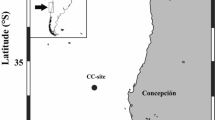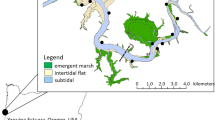Abstract
Phaeocystis spp. cell and colony mass fluxes and their contribution to the vertical particulate organic carbon (POC) export from a wide range of stations were quantified by short-term sediment traps. The compilation of available data, ranging from polar to sub-arctic and boreal regions, revealed that Phaeocystis colonial and single cells frequently are observed in shallow sediment traps at 30–50 m depth (average of 7 ± 11% of POC export). A strong vertical export decline between 40 m and 100 m diminished the contribution of Phaeocystis spp. cell carbon to vertical export of POC to only 3 ± 2% at 100 m depth, with two exceptions (deeper mixed stations). Estimates of potential corresponding mucus contribution increased the average Phaeocystis spp. contribution to <5% of POC export. The vertical flux attenuation efficiency is higher for Phaeocystis spp. than for diatoms. The overall contribution of Phaeocystis spp. to vertical carbon export based on direct investigations of vertical organic carbon export is small.








Similar content being viewed by others
References
Alldredge AL, Passow U, Logan BE (1993) The abundance and significance of a class of large, transparent organic particles in the ocean. Deep-Sea Res 40:1131–1140
Andreassen IJ, Wassmann P (1998) Vertical flux of phytoplankton and particulate biogenic matter in the marginal ice zone of the Barents Sea in May 1993. Mar Ecol Prog Ser 170:1–14
Asper VL, Smith WOJ (2003) Abundance, distribution and sinking rates of of aggregates in the Ross Sea, Antarctica. Deep-Sea Res I 50:131–150
Belviso S, Thouzeau G, Schmidt S, Reigstad M, Wassmann P, Arashkevich E, Stefels J (2006) Significance of vertical flux as a sink for surface water DMPS and as a source for the sediment surface in coastal zones of northern Europe. Estuar Coast Shelf 68:473–488
Coppola L, Roy-Barman M, Wassmann P, Mulsow S, Jeandel C (2002) Calibration of sediment traps and particulate organic carbon export using 234Th in the Barents Sea. Mar Chem 80:11–26
DiTullio GR, Grebmeier JM, Arrigo KR, Lizotte MP, Robinson DH, Leventer A, Barry JP, VanWoert ML, Dunbar RB (2000) Rapid and early export of Phaeocystis antarctica blooms in the Ross Sea Antarctica. Nature 404:595–598
Dutz J, Koski M (2006) Trophic significance of solitary cells of the prymnesiophyte Phaeocystis globosa depends on cell type. Limnol Oceanogr 51:1230–1238
Eilertsen HC, Schei B, Taasen JP (1981) Investigations on the plankton community of Balsfjorden, northern Norway: the phytoplankton 1976–1978. Abundance, species composition and succession. Sarsia 66:129–141
Engel A, Passow U (2001) Carbon and nitrogen content of transparent exopolymer particles (TEP) in relation to their Alcian Blue adsorption. Mar Ecol Prog Ser 219:1–10
Goffart A, Catalano G, Hecq JH (2000) Factors controlling the distribution of diatoms and Phaeocystis in the Ross Sea. J Mar Syst 27:161–175
Gowing MM, Garrison DL, Kunze HB, Winchell CJ (2001) Biological components of Ross Sea short-term particle fluxes in the austral summer of 1995–1996. Deep-Sea Res I 48:2645–2671
Hamm C, Reigstad M, Wexels Riser C, Mühlebach A, Wassmann P (2001) On the trophic fate of Phaeocystis pouchetii: VII. Sterols and fatty acids reveal sedimentation of Phaeocystis-derived organic matter via krill fecal strings. Mar Ecol Prog Ser 209:55–69
Hamm C, Simson DA, Merkel R, Smetacek V (1999) Colonies of Phaeocystis globosa are protected by a thin but tough skin. Mar Ecol Prog Ser 187:101–111
Hamm CE, Rousseau V (2003) Composition, assimilation and degradation of Phaeocystis globosa-derived fatty acids in the North Sea. J Sea Res 50:271–283
Head EJH, Horne EPW (1993) Pigment Transformation and Vertical Flux in an Area of Convergence in the North-Atlantic. Deep-Sea Res II 40:329–346
Heimdal BR (1974) Composition and abundance of phytoplankton in the Ullsfjord area, North Norway. Astarte 7:17–42
Hong Y, Smith WO, White A-M (1997) Studies on transparent exopolymer particles, (TEP) produced in the Ross Sea (Antarctica) and by Phaeocystis antarctica (Prymnesiophyceae). J Phycol 33:368–376
Irigoien X, Meyer B, Harris R, Harbour D (2004) Using HPLC pigment analysis to investigate phytoplankton taxonomy: the importance of knowing your species. Helgol Mar Res 58:77–82
Lalande C (2006) Vertical export of biogenic carbon in the Barents and Chukchi Seas. PhD thesis. University of Knoxville, Tennessee
Lancelot C, Keller MD, Rousseau V, Smith WOJ, Mathot S (1998) Autecology of the marine haptophyte Phaeocystis sp. In: Anderson DM, Cembella AD, Hallegraeff GM (eds) Physiological ecology of harmful algal blooms. Springer-Verlag, Berlin Heidelberg, pp 209–224
Lutter S, Taasen JP, Hopkins CCE, Smetacek V (1989) Phytoplankton dynamics and sedimentation prosesses during spring and summer in Balsfjord, northern Norway. Polar Biol 10:113–124
Mari X, Rassoulzadegan F, Brussard CPD, Wassmann P (2005) Dynamics of transparent exopolymeric particles (TEP) production by Phaeocystis globosa under N- or P- limitation: A controlling factor of the retention/export balance. Harmful Algae 4:895–914
Mathot S, Smith WOJ, Carlson CA, Garrison DL, Gowing MM, Vickers CL (2000) Carbon partitioning within Phaeocystis antarctica (Prymnesiophyceae) colonies in the Ross Sea. J Phycol 36:1049–1056
Menden-Deuer S, Lessard EJ (2000) Carbon to volume relationships for dinoflagellates, diatoms and other protist plankton. Limnol Oceanogr 45:569–579
Olli K, Wassmann P, Reigstad M, Ratkova TN, Arashkevich E, Pasternak A, Matrai P, Knulst J, Tranvik L, Haarakalju R, Jakobsen A (2007) The fate of production in the central Arctic Ocean-top-down regulation by zooplankton expatriates? Prog. Oceanogr 72(1):84–113
Olli K, Wexels Riser C, Wassmann P, Ratkova TN, Arashkevich E, Pasternak A (2002) Seasonal variation in vertical flux of biogenic matter in the marginal ice zone and the central Barents Sea. J Mar Syst 38:189–204
Pakhomov EA, Froneman PW, Wassmann P, Ratkova T, Arashkevich E (2002) Contribution of algal sinking and zooplankton grazing to downward flux in the Lazarev Sea (Southern Ocean) during the onset of phytoplankton bloom: a lagrangian study. Mar Ecol Prog Ser 233:73–88
Passow U (2000) Formation of transparent expopolymer particles, TEP, from dissolved precursor material. Mar Ecol Prog Ser 192:1–11
Passow U (2002) Transparent exopolymer particles (TEP) in aquatic environments. Prog Oceanogr 55:287–333
Passow U, Alldredge AL (1995) A dye-binding assay for the spectrophotometric measurement of transparent exopolymer particles (TEP). Limnol Oceanogr 40:1326–1335
Passow U, Wassmann P (1994) On the trophic fate of Phaeocystis pouchetii (Hariot): IV. The formation of marine snow by P. pouchetii. Mar Ecol Prog Ser 104:153–161
Ratkova TN, Wassmann P (2002) Seasonal variation and spatial distribution of phyto- and protozooplankton in the central Barents Sea. J Mar Syst 38:47–75
Reigstad M (2000) Plankton community and vertical flux of biogenic matter in north Norwegian fjords: Regulating factors, temporal and spatial variations. PhD thesis. Norwegian College of Fishery Science. University of Tromsø, Tromsø
Reigstad M, Wassmann P, Ratkova T, Arashkevich E, Pasternak A, Øygarden S (2000) Comparison of the springtime vertical export of biogenic matter in three northern Norwegian fjords. Mar Ecol Prog Ser 201:73–89
Reigstad M, Wassmann P, Wexels Riser C, Øygarden S, Rey F (2002) Variations in hydrography, nutrients and chlorophyll a in the marginal ice zone and the central Barents Sea. J Mar Syst 38:9–29
Riebesell U (1993) Aggregation of Phaeocystis during phytoplankton spring blooms in the southern North Sea. Mar Ecol Prog Ser 96:281–289
Riebesell U, Reigstad M, Wassmann P, Noji T, Passow U (1995) On the trophic fate of Phaeocystis pouchetii (Hariot): VI. Significance of Phaeocystis-derived mucus for vertical flux. Netherland J Sea Res 33:193–203
Rijssel Mv, Hamm CE, Gieskes WWC (1997) Phaeocystis globosa (Prymnesiophyceae) colonies: hollow structures built with small amounts of polysaccharides. Eur J Phycol 32:185–192
Rousseau V, Becquevort S, Parent JY, Gasparini S, Daro MH, Tackx M, Lancelot C (2000) Trophic efficiency of the planktonic food web in a coastal ecosystem dominated by Phaeocystis colonies. J Sea Res 43:357–372
Rousseau V, Mathot S, Lancelot C (1990) Calculating carbon biomass of Phaeocystis sp. from microscopic observations. Mar Biol 107:305–314
Sakshaug E (2004) Primary and secondary production in the Arctic Seas. In: Stein R, Macdonald RW (eds) The organic carbon cycle in the Arctic Ocean. Springer-Verlag, Berlin Heidelberg, pp 57–81
Schoemann V, Becquevort S, Stefels J, Rousseau V, Lancelot C (2005) Phaeocystis blooms in the global ocean and their controlling mechanisms: a review. J Sea Res 53:43–66
Semina HJ (1978) Treatment of an aliquot sample. In: Sournia A (ed) Phytoplankton manual. Unesco publications, Paris, p 181
Smayda TJ (1978) From phytoplankters to biovolume. In: Sournia A (ed) Phytoplankton manual. Unesco publications, Paris, pp 273–279
Smith WO, Jr. Codispoti LA, Nelson DM, Manley T, Buskey EJ, Niebauer HJ, Cota GF (1991) Importance of Phaeocystis blooms in the high-latitude ocean carbon cycle. Nature 352:514–516
Sukhanova IN, Flint MV (2001) Phaeocystis pouchetii at the Eastern Bering Sea Shelf. Oceanology 41:75–85
Turner JT (2002) Zooplankton fecal pellets, marine snow and sinking phytoplankton blooms. Aquat Microb Ecol 27:57–102
Turner JT, Ianora A, Esposito F, Carotenuto Y, Miralto A (2002) Zooplankton feeding ecology: does a diet of Phaeocystis support good copepod grazing, survival, egg production and egg hatching success? J Plankton Res 24:1185–1195
Urban-Rich J, Nordby E, Andreassen IJ, Wassmann P (1999) Contribution by mesozooplankton faecal pellets to the carbon flux on Nordvestbanken, North Norwegian shelf 1994. Sarsia 84:253–264
Veldhuis MJW, Wassmann P (2005) Bloom dynamics and biological control of a high biomass HAB species in European coastal waters: a Phaeocystis case study. Harmful Algae 4:805–809
Verity PG, Smetacek V (1996) Organism life cycles, predation, and the structure of marine pelagic ecosystems. Mar Ecol Prog Ser 130:277–293
Wassmann P (1991) Sampling and analysis of marine particles with PEBENOCO (PElagic-BEntic coupling in the NOrwegian COastal zone), University of Tromsø, Norway. Geophys Monogr 63:97–99
Wassmann P (1994) Significance of sedimentation for the termination of Phaeocystis blooms. J Mar Syst 5:81–100
Wassmann P, Olli K, Wexels Riser C, Svensen C (2003) Ecosystem function, biodiversity and vertical flux regulation in the twilight zone. In: Wefer G, Lamy F, Mantoura F (eds) Marine science frontiers for Europe. Springer-Verlag, Berlin Heidelberg New York Tokyo, pp 277–285
Wassmann P, Ratkova TN, Reigstad M (2005) The contribution of single and colonial cells of Phaeocystis pouchetii to spring and summer blooms in the north-eastern North Atlantic. Harmful Algae 4:823–840
Wassmann P, Reigstad M, Øygarden S, Rey F (2000) Seasonal variation in hydrography, nutrients and suspended biomass in a subarctic fjord: applying hydrographic features and biological markers to trace watermasses and circulation significant for phytoplankton production. Sarsia 85:237–249
Wassmann P, Vernet M, Mitchell BG, Ray F (1990) Mass sedimentation of Phaeocystis pouchetii in the Barents Sea. Mar Ecol Prog Ser 66:183–195
Wexels Riser C, Wassmann P, Olli K, Pasternak A, Arashkevich E (2002) Seasonal variation in production, retention and export of zooplankton faecal pellets in the marginal ice zone and the central Barents Sea. J Mar Syst 38:175–188
Whipple SJ, Patten BC, Verity PG (2005) Colony growth and evidence for colony multiplication in Phaeocystis pouchetii (Prymnesiophyceae) isolated from mesocosm blooms. J Plankton Res 27:495–501
Acknowledgement
The tedious microscopic effort by Tatjana Ratkova made this contribution possible, and is highly acknowledged. Contributions from colleagues through discussions and fieldwork over many years during the ESCAPE (EU-MAS3-CT96-0050) and BIOHAB (EU-EVK3-CT99-00015) projects, the fjord projects within North Norwegian Coastal ecology (NFR), ALV (NFR 121521/720), CABANERA (NFR 155936/700), MACESIZ (NFR 155945/700) and the Arctic Ocean Expedition-2001, are highly acknowledged as well as the economic support received through these projects. This publication is a contribution to all those projects, and to the SCOR#120 working group. We appreciate constructive comments from two anonymous referees, and thank the organisers of the symposium “Phaeocystis, major link in the biogeochemical cycling of climate-relevant elements” for the opportunity to publish these data.
Author information
Authors and Affiliations
Corresponding author
Rights and permissions
About this article
Cite this article
Reigstad, M., Wassmann, P. Does Phaeocystis spp. contribute significantly to vertical export of organic carbon?. Biogeochemistry 83, 217–234 (2007). https://doi.org/10.1007/s10533-007-9093-3
Received:
Accepted:
Published:
Issue Date:
DOI: https://doi.org/10.1007/s10533-007-9093-3




